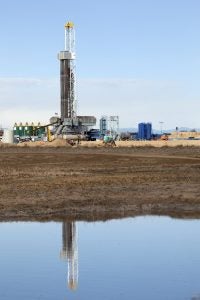 Climate change is drastically raising demands on the world’s fresh water supplies, and as a result, governments, scientists, and others are actively searching for new ways to manage and preserve our water resources.
Climate change is drastically raising demands on the world’s fresh water supplies, and as a result, governments, scientists, and others are actively searching for new ways to manage and preserve our water resources.
One consideration includes repurposing wastewater generated from on-shore oil and gas development, which produces a whopping 900 billion gallons of water annually in the U.S. alone.
Some proponents of this option believe produced water may be a massive opportunity for water-scarce regions. Researchers at the University of Texas suggest recycling produced water for hydraulic fracturing operations could help address anticipated water shortage problems in the Permian Basin. Recycling wastewater within the oilfield is a viable option – as long as the spill and leaks, which can have significant and long-lasting negative impacts on soil and water resources, are minimized.
However, uses beyond the oilfield are much riskier if we don’t answer some critical questions first.
What is in oil and gas wastewater?
“If you’re worried about introducing this water to places where it could interact with the environment or human health, it’s impossible to say if it’s dangerous or not because we simply do not know.” – Karl Oetjen, Colorado School of Mines
Oil and gas wastewater contains a range of constituents including organics, inorganics, and potentially radionuclides. According to data reported to FracFocus and other current literature, there are more than 2,500 different chemicals that could be a found in this wastewater — from hydrochloric acid to ethylene glycol (antifreeze). Recent literature suggests there is still a lot we don’t know about these chemicals. For those 2,500 chemicals, we lack key toxicity data and only have standard analytical methods for less than 20% — and even those don’t always work. Produced water can be 10 times saltier than seawater or more, and testing technologies do not always perform accurately in such high salt content.
Determining what is in the wastewater and whether or not it is hazardous is critical. Policy makers can’t develop effective standards for treated wastewater if they don’t know what water quality targets should be or what tools are needed for effective chemical detection.
We must reduce these data gaps before introducing produced water to new ecosystems. If we fail to do so, and certain chemicals turn out to be harmful, we risk creating more problems than we solve.
For example, in Pennsylvania the discharge of produced water into fresh water sources led to increased radioactivity in stream sediments even after the water was treated. Without fully understanding both the short-term and the long-term consequences of introducing produced water to our ecosystems, unexpected impacts like this could be repeated.
Academia and industry must unite
To begin to address this problem, we must take a step back and get a big-picture look at what we know and what we need to know to make smart decisions on repurposing produced water.
The process for understanding whether water is fit for its intended purposes requires a multi-faceted, collaborative approach, which involves baseline initiatives including evaluating the efficacy of current treatment technologies, improving capabilities for detecting chemicals and understanding toxicological risks, and establishing water quality targets.
Scientific and technical progress in the near term will require collaboration and data sharing between researchers and industry operatives. Increased cooperation will help the scientific community identify patterns that could indicate unhealthy elements in water samples.
It is also incumbent upon oil and gas companies (and those permitting their practices) to help ensure that repurposing produced water doesn’t create more problems than it solves. Industry-funded research or research facilitated by oil and gas companies will be a crucial part of advancing the science, and by simply making their wastewater streams available to researchers, industry could go a long way in bridging our current knowledge gaps.
The good news is we’re seeing a trend in the right direction. Professional societies, such as The Society of Environmental Toxicology and Chemistry and the American Chemical Society have made produced water characterization a priority by facilitating and organizing technical sessions at their national meetings to present and share research. The Ground Water Protection Council is also working together with regulators, industry partners, and NGOs to identify research priorities so informed decisions can be made in the future on produced water reuse outside the oilfield. Additionally, EDF collaborates with a variety of research teams at universities across the country to push the science on chemical characterization and hazard assessment of this complex wastewater.
These are all positive signs, but until more researchers engage on expanding the science, we can’t embrace reusing produced water outside of the oilfield as a low risk solution to water scarcity.









